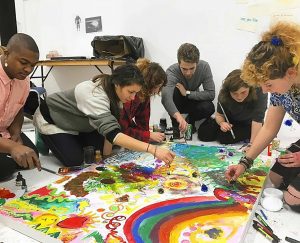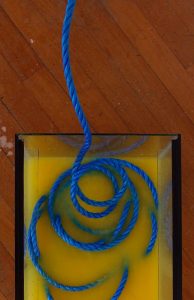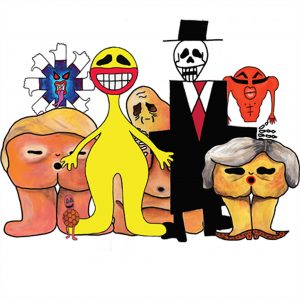DJCAD DEGREE SHOW 2017: Art & Philosophy
This year’s degree show for Art and Philosophy offers the viewer a wealth of thought-provoking art works. There are interesting connections between artists’ interests, yet outcomes are hugely varied.
Stacey Pover emphasises the healing qualities of art and the power of collaborative expression in performances. She asks participants to take part spontaneously in creating paintings outside the building. She then records these performances, allowing the viewer to see how people interact with each other, with the canvas and the space around them. There is something therapeutic about this practice, and Pover shows that making something together can offer a platform for further discussion.
Another artist seeking to open room for discussion is Mhairi Anton. Her works are strikingly personal. Working within the medium of printmaking, she utilises her own writing and photography to relate personal experiences. Her work in neon lettering Where Do We Go from Here immediately prompts the viewer to reflect on the similarities between their life and that of the artist’s.
Emma McCarthy’s performance on opening night sparked discussion about collaborative methods and different modes of choreography. Rehearsal Series is a performance involving meditative, paced-down actions. Performers follow certain instructions yet also interacted intuitively, engaging viewers with the immediacy of the work. Emma Nellies’ art is placed near McCarthy’s exhibit, and they have in the past frequently collaborated with each other. Nellies’ choice of materials is interesting. She has placed a blue rope in a translucent box of yellow custard; the rope is messy as it combines with the custard. Nellies plays on these materials to create an unconventional art piece; in doing so, her materials’ functionality and their associative meanings are questioned.
Kirsten Bennie has created an immersive installation of monsters. At first glance it could be a children’s’ playground, yet the characters she has created are also real life monsters. including Theresa May and Donald Trump. She highlights the similarities of our fears as children and as adults, implying that our childish imaginings are often telling and true. Bennie’s work takes us into another world albeit briefly; yet this world affects us daily. In a similar vein, Rhoda Ellis’ immersive virtual reality releases us from the every day. We see the physical world before us and are then instantly taken into the depths of the digital world. That mirage is striking and leads the viewer to consider the future possibilities of technology.
James Alexander McKenzie’s sculptural paintings are a collage of a variety of mediums and experiments. The layering of paint, paper and text is lucid and energetic and contains an interesting array of elements; their combination makes the paintings rich, and there seems to be a definite subconscious playfulness in his making, adding depth to the works. Shona Grant’s approach to combining landscape and portraiture is fresh and exciting. The female figure is the focal point in the foreground with the landscape framed in the background. Her choice of materials ‒ watercolour, pencil, pen ‒ adds a lovely subtlety to the art. As the pieces are similar in composition and framed individually, positioned together they seem like contemporary pre-Raphaelite studies.
Doaa Yule’s work is as intriguing as it is enquirying. Conceptually her practice questions what would appear to be solid or absolute; within her darkened space, she utilises a variety of media ‒ light, sculpture and text. In Vicious Circle, she creates a literal vicious cycle; yet this is not how vicious circles exist.
It has been a fantastic year for Art and Philosophy students. Each artist has come to a pivotal point in their practice that can only lead to exciting future developments.





Leave a Reply